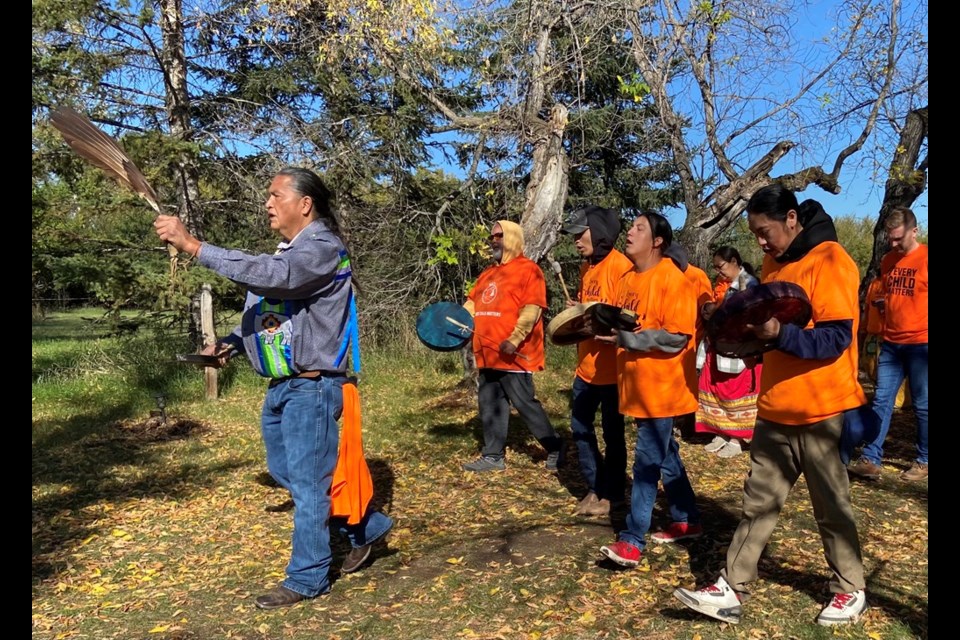THE RIDGE, BATTLEFORD - The sound of the beating drum guided supporters walking in their sun-dappled orange shirts at The Ridge, south of Battleford, on Monday.
It was all part of the events to mark the National Day for Truth and Reconciliation. The day honours the children who never returned home and survivors of residential schools.
Sunchild Law hosted the activities at The Ridge, the land that's now owned by Mosquito, Grizzly Bear's Head, Lean Man First Nation.
Eleanore Sunchild, owner of Sunchild Law, spoke to the many people who gathered to take part in the ceremonial walk to the Battleford Industrial School Cemetery, where at least 74 children who attended the school, which operated from 1883 to 1914, are buried.
"We started doing this walk many years ago, even before there was an Orange Shirt Day," she said.
Orange Shirt Day commemorates the time in Canada’s history when Indigenous children were taken away from their homes to residential schools. It was started by Phyllis Webstad, from B.C., who went to St. Joseph's Mission residential school as a child. She recalled how her special orange shirt that was given to her by her grandmother was taken away from her on her first day at residential school. So, Orange Shirt Day was started to recognize her story.
"They put her in a uniform and cut her hair, and she never forgot about that orange shirt," said Sunchild. "She decided to dedicate a day to residential school survivors, and she called it 'Orange Shirt Day.'"
Sunchild said the impact from residential school can be seen today, through inter-generational trauma experienced by children of residential school survivors.
"We see them in the Battlefords a lot, because there is a big Indigenous population here, of people who went to Indian residential school," Sunchild said. "There were so many abuses in the schools, and that affected the whole family. It's a nation-wide issue what happened in the residential schools. We see the impacts in the number of children in foster care, the addictions... All of these things can be traced back to the [residential] schools. And the high number of missing and murdered Indigenous women, and the over-representation of Indigenous people incarcerated in jails, [and in] a poverty. All of that, it goes back to the schools."
She noted that the last Indian residential school closed in 1997, so the history is not that long ago.
Sunchild hopes that education is one way to help respond to the impact from residential schools today.
"Education is the key, the start," she said. "And compassion, helping those who can't help themselves, who are so traumatized that they don't see the way out. Understanding and compassion. That's what a lot of the families of survivors require, because it's really hard to talk about what happened in those schools."
Sunchild said she sees hope for the future as more people come out to participate in the walk at The Ridge each year.
"I see hope because on this day it's a national holiday," she said. "I see hope because people are actually talking about what happened in the schools, are beginning to understand what happened in the schools relates to what you see today.... Keep that in mind, and open your heart."
Statue vandalized
Young elder Alvin Baptiste spoke about the beautiful statue by artist Lionel Peyachew that is now on display at Central Park in North Battleford. The piece, entitled "Annie Peyachew," pays homage to the young girl who is among those children buried at the Battleford Industrial School Cemetery.
"We've been working on this project for eight years," he said. "We wanted to do something to commemorate the survivors of the residential schools. We wanted to put up something that is going to last over decades. So, we came up with the idea to erect a statue."
Baptiste noted that Peyachew never made it home.
"Her parents were never notified of her death," he said. "Today her remains are buried over at the cemetery."
Baptiste noted there is a significant amount of systemic racism in society to deal with.
"It's everywhere," he said.
"We're going to build a good future for our children," Baptiste added ."Our children learn from home... We have to start from the homes and start educating our children about racism, and not really knowing who we are as First Nations people."
Baptiste bemoaned that the new statue was vandalized the day after it was unveiled Friday. Black marker was drawn onto its face by someone. Fortunately, it was possible to remove the stain using hand sanitizer, and the sculpture has since been returned to its original state.
"I felt sad about it because we worked so hard to get this project going," said Baptiste. "Then, somebody went over there and vandalized it like that."
He said fortunately the statue has been restored.
"We'll keep fighting to make a better future for our children in North Battleford and the Battlefords region here. I'm looking forward to each and every one of you to coming to check out that really awesome statue," Baptiste said. "It's a beautiful statue."




